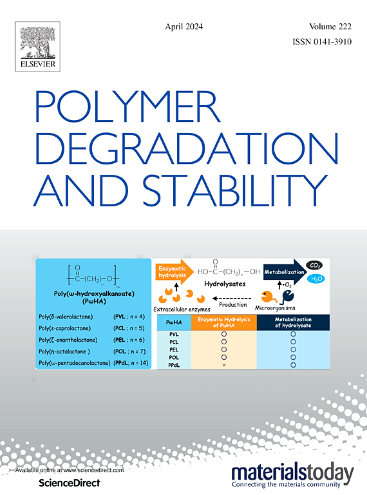Compression stress relaxation characteristics and failure mechanism of silicone rubber for high voltage cable accessories
IF 6.3
2区 化学
Q1 POLYMER SCIENCE
引用次数: 0
Abstract
Sufficient interfacial pressure between silicone rubber (SIR) insulation and cross-linked polyethylene (XLPE) in high-voltage cable accessories is the basic condition to ensure the normal operation of cable accessories. However, in the actual operation of cables and accessories, high-temperature aging and mechanical aging can cause the mechanical properties of SIR materials to decline, thus affecting the size of the insulation interface pressure. Firstly, the relaxation law of compressive stress of SIR material is obtained by measuring the compressive stress under force-thermal synergistic aging. Secondly, the time-temperature equivalent model is established according to the measured data to evaluate the service life of the cable accessories. Thirdly, the physical and chemical properties of SIR with different aging times are tested to analyze the change in its mechanical properties. Finally, the effect of temperature on the stress relaxation characteristics of SIR is calculated from the microscopic level by molecular simulation. The experimental results show that the compressive stress of SIR decreases first and then becomes stable with the increase of aging time due to the movement of molecular chains and chemical reactions in SIR. In addition, the compression stress relaxation rate of SIR increases with temperature. The aging life prediction model shows that when the relaxation coefficient of compressive stress drops to 50% of the initial value at the end of cable life, the service life of cable accessories at 70°C is about 24 years. The molecular simulation shows that the relaxation of the molecular chain of SIR is accelerated with the increase in temperature, and the stress relaxation of SIR material is accelerated on a macroscopic level. This research can provide a theoretical basis for the design and operation reliability of cable accessories.
高压电缆附件用硅橡胶压缩应力松弛特性及失效机理
高压电缆附件中硅橡胶(SIR)绝缘与交联聚乙烯(XLPE)之间有足够的界面压力是保证电缆附件正常工作的基本条件。但在电缆及附件的实际使用中,高温老化和机械老化会导致SIR材料的力学性能下降,从而影响绝缘界面压力的大小。首先,通过测量应力-热协同老化条件下SIR材料的压缩应力,得到了压缩应力的松弛规律;其次,根据实测数据建立时间-温度等效模型,对电缆附件的使用寿命进行评估。第三,对不同时效时间SIR的理化性能进行测试,分析其力学性能的变化。最后,通过分子模拟从微观层面计算了温度对SIR应力松弛特性的影响。实验结果表明,随着老化时间的延长,由于SIR中分子链的移动和化学反应,SIR的压缩应力先减小后趋于稳定,压缩应力松弛速率随温度的升高而增大。老化寿命预测模型表明,当电缆寿命结束时压应力松弛系数降至初始值的50%时,电缆附件在70℃下的使用寿命约为24年。分子模拟结果表明,SIR分子链的弛豫随着温度的升高而加速,SIR材料的应力弛豫在宏观层面上加速。该研究可为电缆附件的设计和运行可靠性提供理论依据。
本文章由计算机程序翻译,如有差异,请以英文原文为准。
求助全文
约1分钟内获得全文
求助全文
来源期刊

Polymer Degradation and Stability
化学-高分子科学
CiteScore
10.10
自引率
10.20%
发文量
325
审稿时长
23 days
期刊介绍:
Polymer Degradation and Stability deals with the degradation reactions and their control which are a major preoccupation of practitioners of the many and diverse aspects of modern polymer technology.
Deteriorative reactions occur during processing, when polymers are subjected to heat, oxygen and mechanical stress, and during the useful life of the materials when oxygen and sunlight are the most important degradative agencies. In more specialised applications, degradation may be induced by high energy radiation, ozone, atmospheric pollutants, mechanical stress, biological action, hydrolysis and many other influences. The mechanisms of these reactions and stabilisation processes must be understood if the technology and application of polymers are to continue to advance. The reporting of investigations of this kind is therefore a major function of this journal.
However there are also new developments in polymer technology in which degradation processes find positive applications. For example, photodegradable plastics are now available, the recycling of polymeric products will become increasingly important, degradation and combustion studies are involved in the definition of the fire hazards which are associated with polymeric materials and the microelectronics industry is vitally dependent upon polymer degradation in the manufacture of its circuitry. Polymer properties may also be improved by processes like curing and grafting, the chemistry of which can be closely related to that which causes physical deterioration in other circumstances.
 求助内容:
求助内容: 应助结果提醒方式:
应助结果提醒方式:


